Cao Z. (Ed.) Thin Film Growth: Physics, materials science and applications
Подождите немного. Документ загружается.

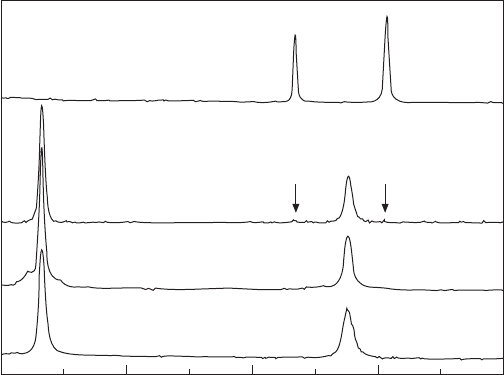
198 Thin film growth
© Woodhead Publishing Limited, 2011
can say with condence that the Cu phases emerge from the decomposed
stoichiometrical Cu
3
N, revealed by XRD, only at a temperature of ~350°C
by annealing under the protection of nitrogen at a pressure of 0.9 Pa.
8.3 Nitrogen re-emission
The thermal instability of copper nitrides constitutes essential difculties
for their synthesis and structural characterization. By reactive magnetron
sputtering deposition of copper nitride lms, the effect of nitrogen re-emission
on the lm morphology may be directly observable, from which the effect
on the growth process and on the microscopic structure of deposits can be
inferred. The investigation of this topic is also helpful in understanding the
failure mechanism of copper nitrides in usage, which may cause serious
instability problems in practical applications.
To demonstrate the effect of nitrogen re-emission, copper nitride thin lms
were grown with mixed nitrogen (of 60% to 80% in ow rate) and argon as
working gas, maintained at a pressure of 1.1–1.3 Pa. The power supply was
set at 150 W. Under the given conditions, the deposits are substoichiometric
with copper contents exclusively below 77.6%. Under SEM, the lms grown
for 15 minutes, which are roughly 0.3 mm thick, display a morphology with
isolated round blisters (Fig. 8.10). These blisters are typically about 10
microns in dimension. The coverage by these protruding features is about
20%. In lms deposited for 30 minutes, the protruding features turned into
Intensity (arb. units)
20 30 40 50 60
2q (deg)
Cu
3
N(001)
Cu(111)
Cu(002)
Cu
3
N(002)
420°C
350°C
300°C
220°C
8.9 XRD patterns of the Cu
3
N films after annealing at temperatures
varying from 220°C to 420°C.
ThinFilm-Zexian-08.indd 198 7/1/11 9:42:07 AM
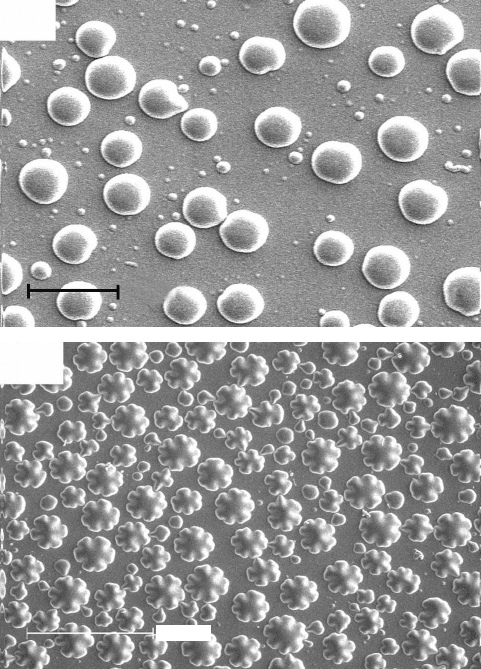
199Thin film growth for thermally unstable noble-metal nitrides
© Woodhead Publishing Limited, 2011
a ramied rosette-like structure. Such copper nitride rosettes are distributed
homogeneously across the sample surface, and show a striking size and
shape uniformity, with a lateral dimension around 23 microns (Fig. 8.10).
By close inspection of the individual rosettes, it is observed that the rays
bifurcate at an average angle of ~74°, slightly larger than the wedge angle
of 71.53° for a tetrahedron. In some well-developed ones, vefold symmetry
can be conrmed at the center of the rosettes, though not as strict as in the
geometrical sense.
At rst glance, this morphology reminds us of island formation as frequently
encountered in growing crystalline lms, which can be generally modeled with
(a)
20 µm
(b)
100 µm
8.10 Effect of nitrogen re-emission on the morphology of copper
nitride films. A 0.3 mm thick film exhibits distinct round blisters (a),
while in a film grew to ~0.6 mm thick, rosettes with bifurcated rays
were observed (b). The rosettes are generally quintilobed, often
fivefold symmetry can be identified at the centers.
ThinFilm-Zexian-08.indd 199 7/1/11 9:42:07 AM
200 Thin film growth
© Woodhead Publishing Limited, 2011
an atomistic view. But we found that this is not the case. Both the smaller
round caps and the larger rosettes are hollow, as conrmed by the presence
of some cracked entities. When probing through the crack of a broken rosette,
the energy-dispersive X-ray spectrometry detected a dominantly strong signal
only for silicon and a weak signal for copper – the nitrogen is completely
absent. This is to say that the protruding features are due to a complete local
detachment of the lm; and in that process some tiny amount of copper is
left behind on the Si substrate (Ji et al. 2005, 2006a). Nevertheless, such
protruding structures cannot have developed from a previously well-deposited
coating due to the accumulated stress. This point can be claried by briey
examining the necessary area expansion of the material for the formation
of such hollow features. As a conservative estimation, consider a round
cap 20 mm in lateral dimension and 1 mm high. This corresponds to an area
expansion of ~5.0% with regard to the underlying circular base. Such a large
area expansion coefcient is prohibitive for rigid materials such as the ionic
copper nitride. Moreover, such a morphology is formed in the growth stage,
post-growth degradation of an originally at lm due to nitrogen re-emission
leaves behind a at, but Cu-rich surface. The aging of lms with a compact
morphology in the ambient will not invoke any rosette structure.
The puzzle of the enormously expanded area of the rosettes with regard to
the underlying base becomes immediately resolved with the aid of scanning
electron micrographs at an enlarged magnication. We see that the deposits
with rosette structures are composed of distinct crystallites, around 45 nm
in dimension, just like a compact lm, but the SEM images taken directly
on a rosette reveals the peculiarity in the manner of crystallite stacking. The
surface of the rosette structures displays ragged steps and terraces, and it is
thinner than the at portion of the deposits. The typical width of a terrace
is about 100 nm (Fig. 8.11). Such a morphology has never been reported,
to the best knowledge of the author. We are inspired to speculate that the
crystallites in a rosette have experienced a rearrangement process. The area
expansion in due course of relief formation is sustained through the gliding
of nanocrystals, which is facilitated when the nanocrystals are clothed with
the amorphized Cu-terminated {111}-planes; and the ongoing fast growth
prevents the lm from cracking.
In order to fully understand the formation mechanism for such protruding
features, we take a close look at the morphological prole of the rosettes.
They have the shape of a starsh with rays, but these rays generally do not
meet at the same point in the central disk. Occasionally, a symmetrically
developed rosette could be found, in which a perfect pentagram is discernible
at the center, as shown in Fig. 8.12(a). The rays show further bifurcations,
and the offshoots extend generally at an angle of about 74°, a little larger
than 72° as required by vefold rotational symmetry, which in turn is a little
larger than the wedge angle of a tetrahedron (a = 70.53°). This cannot be
ThinFilm-Zexian-08.indd 200 7/1/11 9:42:07 AM
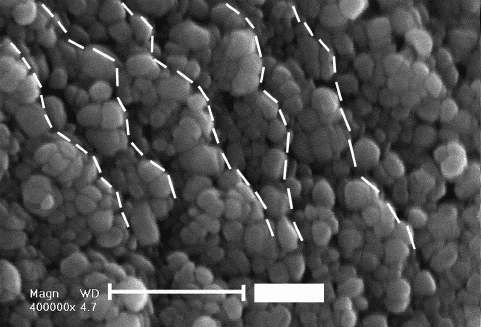
201Thin film growth for thermally unstable noble-metal nitrides
© Woodhead Publishing Limited, 2011
a coincidence, bearing in mind that the tetrahedral crystallites do have the
tendency to juxtapose at an angle of about 72° with a [110] orientation in
order to ll the space, giving rise to a loosely vefold symmetry. Fivefold
symmetry evolving from this construction mechanism has been conrmed
in nanostructures of cubic metals such as Au, Ag and Cu.
As we know, the {111}-planes of the cubic Cu
3
N lattice comprise
exclusively either Cu atoms or N atoms. When nitrogen re-emits from a Cu
3
N
crystallite, it leaves behind crystallites with a soft clothing of amorphous
Cu layer in a habit, not necessarily tetrahedral, but with facets joining at the
wedge angle (a ª 70.53°). The clothing of Cu
3
N crystallites by Cu {111}-
planes also builds a particular electrical conductance path, as veried from
the percolation transition in the variation of its electrical resistivity versus
the Cu content in the lm. When driven by a sufciently large stress, here
initiated by the re-emitted nitrogen gas from beneath, the nanocrystals will
undergo a gliding motion against each other along the {111}-planes, and
conglomeration of a large quantity of such nanocrystals with facets joining
at a ª 70.35° results in vefold symmetry at larger scales. Displayed in Fig.
8.12(b) is a piece of Cu
3
N crystal in a specimen prepared with mechanical
milling for transmission electron microscopic investigation – it is pentagonal
with an edge length of 660 nm.
Now the picture becomes clear. An ‘orogenic movement’ model can be
formulated to illustrate the formation of relief rosettes in a growing Cu
3
N
thin lm (Fig. 8.5). Copper nitride keeps decomposing while lm growth
proceeds. The re-emitted nitrogen atoms recombine into molecules and
together with entrapped nitrogen they agglomerate to form gas bubbles at the
200 nm
8.11 Scanning electron micrographs at a large magnification of the
rosette. Typical crystallite size is 45 nm. The dashed lines are plotted
to guide the eye.
ThinFilm-Zexian-08.indd 201 7/1/11 9:42:07 AM
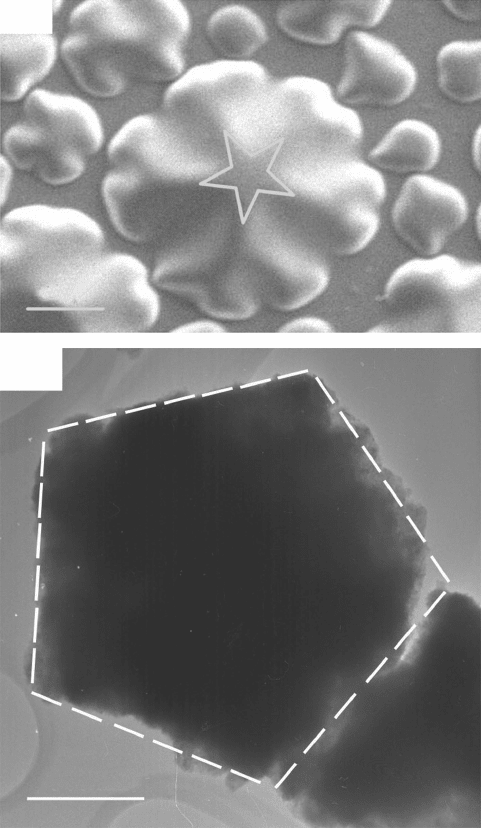
202 Thin film growth
© Woodhead Publishing Limited, 2011
lm–substrate interface by virtue of a large lateral mobility, since solubility
of nitrogen in both Si and Cu
3
N is low. Adhesion to the local substrate is
undermined where a gas bubble forms, and nally detachment occurs (Fig.
8.5(b)). By a delicate balance between expansion via nanocrystal glide and
fast growth, the total area and the lateral dimension of the delaminated
(a)
25 µm
(b)
300 nm
8.12 Fivefoldness in the microstructure of a copper nitride deposit.
(a) A rosette displaying perfect fivefold symmetry at the center; (b)
a pentagonal assembly of the Cu
3
N nanocrystals under transmission
electron microscope.
ThinFilm-Zexian-08.indd 202 7/1/11 9:42:08 AM
203Thin film growth for thermally unstable noble-metal nitrides
© Woodhead Publishing Limited, 2011
part grow in pace without cracking. As can be expected, at reduced growth
rates a compact morphology of the lm ensues. Gliding motion of the
crystallites into ragged steps and terraces – similar to the movement of
rocks in mountain building, i.e. the orogenic movement – provides the path
for a complete strain relaxation; this explains the negligible residual stress
in the sample despite the presence of the relief features, as concluded from
the transmission electron microscopic and X-ray diffraction data about the
lattice constant (Fig. 8.1). The possibility to glide along the Cu-terminated
{111}-planes for the pyramidal Cu
3
N crystallites is prerequisite for the
formation of the relief morphology; this also explains its absence in the lms
of nearly stoichiometrical or heavily Cu-rich samples. As to the quintilobed
structure of the rosettes that ramify at a branching-off angle of ~74°, they
are the consequence of the preferred packing and rearrangement driven by
an anisotropic stress of about two million {111}-faceted Cu
3
N nanocrystals
(Ji et al. 2007). Unlike in the nanorods of cubic metals where the core is
vefold twin crystals textured along the [110]-axis, the vefold symmetry
here is quite ‘soft’ in the sense that it arises rather as an integral effect at
large scales.
8.4 Doping of Cu
3
N by co-sputtering
The structure of Cu
3
N is, in itself, rather interesting. It is an open structure
that can, theoretically, accommodate one more metal ion in each unit cell.
The incorporation of an excess metal atom can signicantly alter the band
structure of the material that continuous semiconducting-to-(semi)metallic
transition can be expected, through which various interesting phenomena
can be measured in the ternary compounds (Lovett 1977). Here, through
the co-sputtering of Cu and Pd targets, we demonstrate the deposition of
ternary Cu
3
NPd
x
thin lms, where a vanishing temperature coefcient of
resistivity (TCR) in the range from 240 K down to 5 K could be measured
in Cu
3
NPd
0.238
(Ji et al. 2006b). Such a phenomenon has not been found in
any other single solids.
The inclusion of another metal atom in each unit cell of the Cu
3
N lattice
results in compounds like Cu
4
N or the ternary Cu
3
NPd (Hahn and Weber 1996).
Remarkably, Cu
3
NPd is a semimetal due to the intersection of the energy
bands at the Fermi level. Consequently, a semiconducting-to-semimetallic
transition is anticipated in the off-stoichiometric Cu
3
NPd
x
when ‘x’ increases
continuously from zero to unity.
We prepared thin lms of Cu
3
N and Cu
3
NPd
x
(0 < x < 0.350) on the Si
(001) wafers, a low substrate temperature (~100°C) in combination with
a small power supply (<150 W) and a high working pressure (>0.7 Pa) is
applied. The interposition of metal atoms at the cell centers of the cubic Cu
3
N
lattice severely deteriorates the covalent bonding in the resulting materials
ThinFilm-Zexian-08.indd 203 7/1/11 9:42:08 AM
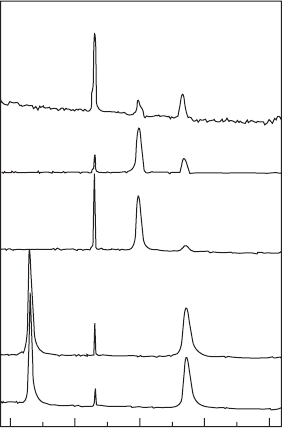
204 Thin film growth
© Woodhead Publishing Limited, 2011
such that the compounds Cu
4
N and Cu
3
NPd only exist in theory. In fact,
the largest reported value of ‘x’ never exceeds 0.989 in Cu
3
NPd
x
whereby
the compounds exist in ne powders (Jacobs and Zachwieja 1991).
We
found that those Cu
3
NPd
x
thin lm samples with x > 0.5 show a very poor
crystallinity; therefore we restrict our discussion to the samples with 0.0 ≤
x ≤ 0.350 which are well crystallized as conrmed by both X-ray diffraction
pattern (Fig. 8.13) and transmission electron micrograph (Fig. 8.14). For
samples containing only a tiny amount of Pd, e.g., Cu
3
NPd
0.048
, the X-ray
diffraction pattern remains unchanged, like that of the host Cu
3
N lattice
showing only the (001) and (002) reections. When the Pd concentration
is large enough (x ≥ 0.175), the (001) reection was replaced by the strong
(111) reection which deteriorates both in intensity and in spectral prole.
We can say that the Cu
3
NPd
x
thin lms here concerned with x < 0.35 are
crystalline. The addition of Pd atoms results in a slightly enlarged lattice
constant which increases from a = 0.383 nm for the pure Cu
3
N to a = 0.385
nm for Cu
3
NPd
0.175
(Fig. 8.14). The Cu
3
NPd
x
samples obviously have a better
electrical conductivity which in turn results in an improved image quality for
the transmission electron micrograph (cf. Fig. 8.7). The fact that the Cu
3
NPd
x
is metallic at sufciently large ‘x’ values, while Cu
3
N is semiconducting,
may suggest that the interposition of Pd atoms alter the energy bands near
the Fermi surface.
Intensity (arb. units)
Si (002)
(111)
(001)
(002)
x = 0.349
x = 0.238
x = 0.175
x = 0.048
Cu
3
N
20 30 40 50 60
2q (deg)
8.13 X-ray diffraction patterns of Cu
3
NPd
x
with varying ‘x’ values.
ThinFilm-Zexian-08.indd 204 7/1/11 9:42:08 AM
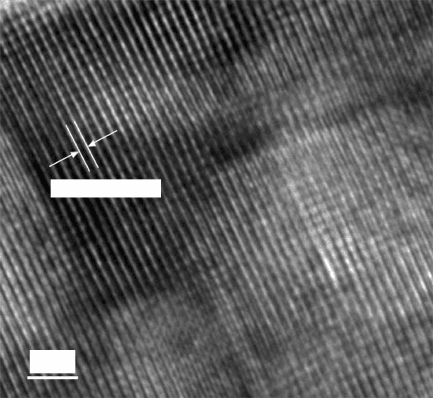
205Thin film growth for thermally unstable noble-metal nitrides
© Woodhead Publishing Limited, 2011
Figure 8.15 displays the temperature dependence of the electrical resisitivty
for the nearly stoichiometric Cu
3
N and for the different ternary Cu
3
NPd
x
compounds. Upon cooling from room temperature, the electrical resistivity
in the intrinsic Cu
3
N lm rises rapidly (Fig. 8.15(a)). This observation is
consistent with the wide band-gap nature of this semiconducting material. The
insertion of Pd atoms confers Cu
3
NPd
x
an improved electrical conductivity
owing to the narrowed band-gap. Even with a tiny amount of Pd insertion
as in the samples with x = 0.048 and x = 0.071, the rapid onset of resistivity
upon cooling is shifted to below 50 K, indicating a narrowed band-gap for
the current samples (Fig. 8.15(b) and (c)). A further addition of Pd atoms
initiates the semiconducting-to-semimetallic transition such that the TCR
changes its sign. For Cu
3
NPd
0.175
, its electrical resistivity rises roughly linearly
with decreasing temperature in a range as wide as 270 K, and the TCR is
–0.00039 K
–1
(Fig. 8.15(d)). Taking T = 280 K as the reference point, the
resistance over such a broad temperature range changes only by ~5.0%. The
resistivity for Cu
3
NPd
0.349
also displays a good linearity from 50 K to 280
K, but now the TCR is 0.00117 K
–1
(Fig. 8.15(f)), indicating unambiguously
that now the compound has changed to be metallic. In between these two
cases of opposite tendencies for the variation of the electrical resistivity with
temperature, we may expect a vanishing TCR over a considerable temperature
range at some ‘x’ value. This occurs in the sample Cu
3
NPd
0.238
. From 240
K down to 5 K, the TCR is nearly zero (< 3.0 ¥ 10
–6
/K), and the relative
variance of the electrical resistivity in this temperature range measures as
small as 1.42 ¥ 10
–5
(Fig. 8.15(e)).
d = 0.3855 nm
2 nm
8.14 Transmission electron micrograph for the sample Cu
3
NPd
0.175
.
ThinFilm-Zexian-08.indd 205 7/1/11 9:42:08 AM
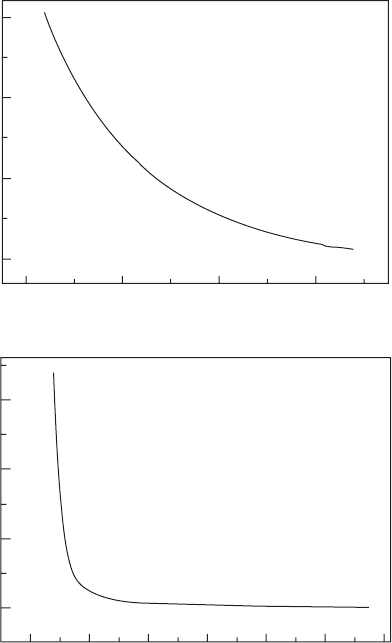
206 Thin film growth
© Woodhead Publishing Limited, 2011
The temperature dependence of the electrical conductivity for solids is
susceptible to many inuencing factors; no hard-and-fast rules are available.
For a semiconductor, the electrical conductivity can be formally written as
s = e(n
e
m
e
+ n
h
m
h
), where e and h denote electron and hole, while n and
m stand for the carrier density and carrier mobility, respectively. Both the
carrier mobility and the carrier density, or the number of the carriers, are
temperature dependent,
yet the temperature dependence of the electrical
conductivity is dominated by that of the latter, since the mobility changes
only in a mild way with the lattice temperature while the number of carriers
Resistivity (10
–1
Wm)
3.0
2.0
1.0
0.0
160 200 240 280
Temeprature (K)
(a)
Resistivity (Wm)
3.0
2.0
1.0
0.0
0 50 100 150 200 250 300
Temperature (K)
(b)
8.15 Temperature (in K) dependence of the electrical resistivity
measured in crystalline Cu
3
NPd
x
thin films. (a) x = 0.0; (b) x = 0.048;
(c) x = 0.071; (d) x = 0.175; (e) x = 0.238; and (f) x = 0.349. From (b)
to (f), the electrical resistivity at room temperature is reduced by four
orders of magnitude.
ThinFilm-Zexian-08.indd 206 7/1/11 9:42:09 AM
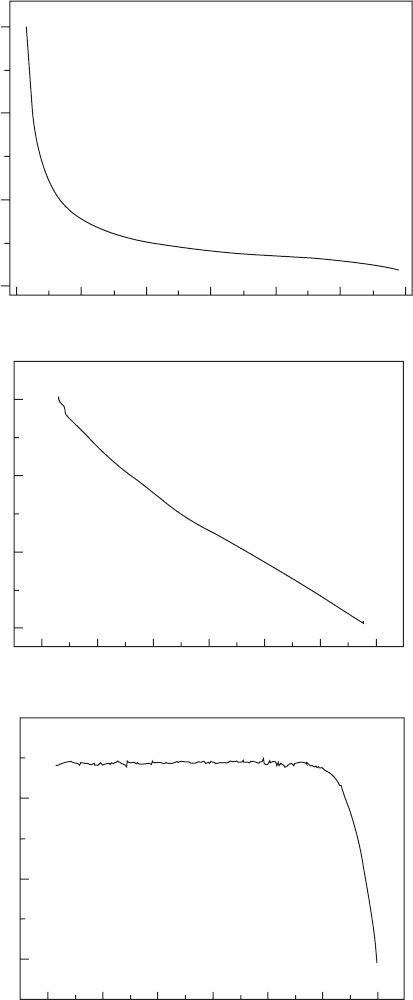
207Thin film growth for thermally unstable noble-metal nitrides
© Woodhead Publishing Limited, 2011
Resistivity (10
–2
Wm)
1.5
1.0
0.5
0.0
0 50 100 150 200 250 300
Temperature (K)
(c)
Resistivity (10
–5
Wm)
2.08
2.04
2.00
1.96
0 50 100 150 200 250 300
Temperature (K)
(d)
Resistivity (10
–5
Wm)
1.14
1.12
1.10
1.08
0 50 100 150 200 250 300
Temperature (K)
(e)
8.15 Continued.
ThinFilm-Zexian-08.indd 207 7/1/11 9:42:09 AM
